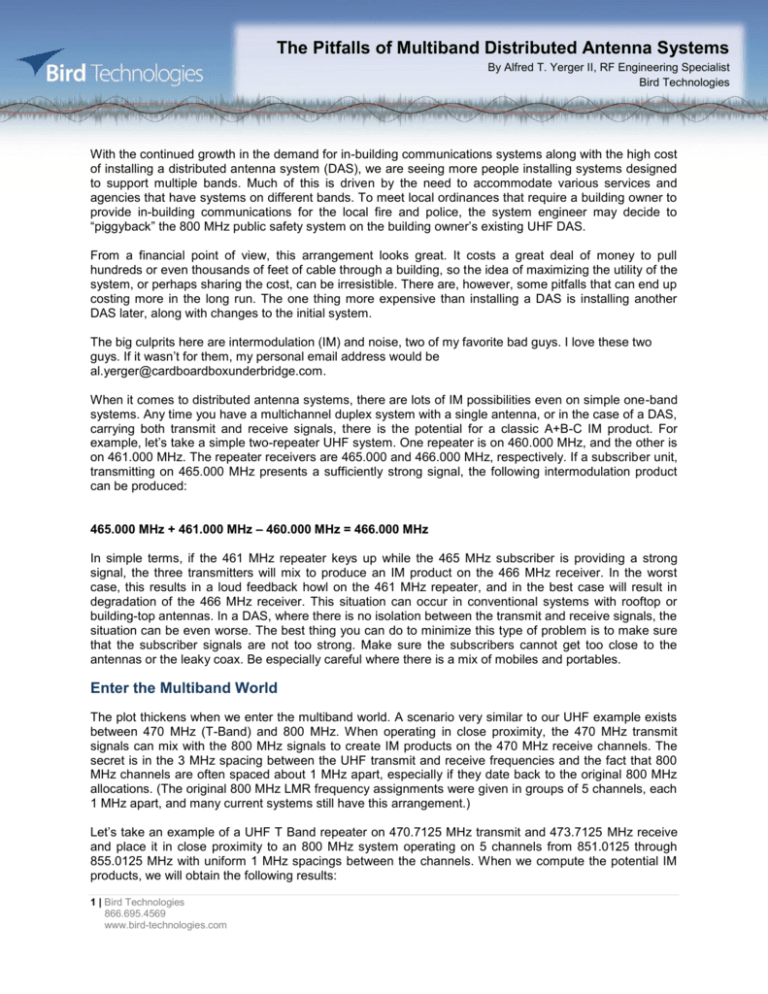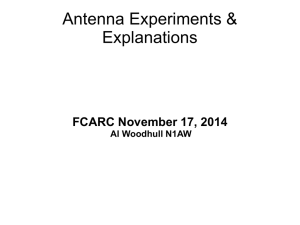Pitfalls of Multiband Distributed Antenna Systems
advertisement

The Pitfalls of Multiband Distributed Antenna Systems By Alfred T. Yerger II, RF Engineering Specialist Bird Technologies With the continued growth in the demand for in-building communications systems along with the high cost of installing a distributed antenna system (DAS), we are seeing more people installing systems designed to support multiple bands. Much of this is driven by the need to accommodate various services and agencies that have systems on different bands. To meet local ordinances that require a building owner to provide in-building communications for the local fire and police, the system engineer may decide to “piggyback” the 800 MHz public safety system on the building owner’s existing UHF DAS. From a financial point of view, this arrangement looks great. It costs a great deal of money to pull hundreds or even thousands of feet of cable through a building, so the idea of maximizing the utility of the system, or perhaps sharing the cost, can be irresistible. There are, however, some pitfalls that can end up costing more in the long run. The one thing more expensive than installing a DAS is installing another DAS later, along with changes to the initial system. The big culprits here are intermodulation (IM) and noise, two of my favorite bad guys. I love these two guys. If it wasn’t for them, my personal email address would be al.yerger@cardboardboxunderbridge.com. When it comes to distributed antenna systems, there are lots of IM possibilities even on simple one-band systems. Any time you have a multichannel duplex system with a single antenna, or in the case of a DAS, carrying both transmit and receive signals, there is the potential for a classic A+B-C IM product. For example, let’s take a simple two-repeater UHF system. One repeater is on 460.000 MHz, and the other is on 461.000 MHz. The repeater receivers are 465.000 and 466.000 MHz, respectively. If a subscriber unit, transmitting on 465.000 MHz presents a sufficiently strong signal, the following intermodulation product can be produced: 465.000 MHz + 461.000 MHz – 460.000 MHz = 466.000 MHz In simple terms, if the 461 MHz repeater keys up while the 465 MHz subscriber is providing a strong signal, the three transmitters will mix to produce an IM product on the 466 MHz receiver. In the worst case, this results in a loud feedback howl on the 461 MHz repeater, and in the best case will result in degradation of the 466 MHz receiver. This situation can occur in conventional systems with rooftop or building-top antennas. In a DAS, where there is no isolation between the transmit and receive signals, the situation can be even worse. The best thing you can do to minimize this type of problem is to make sure that the subscriber signals are not too strong. Make sure the subscribers cannot get too close to the antennas or the leaky coax. Be especially careful where there is a mix of mobiles and portables. Enter the Multiband World The plot thickens when we enter the multiband world. A scenario very similar to our UHF example exists between 470 MHz (T-Band) and 800 MHz. When operating in close proximity, the 470 MHz transmit signals can mix with the 800 MHz signals to create IM products on the 470 MHz receive channels. The secret is in the 3 MHz spacing between the UHF transmit and receive frequencies and the fact that 800 MHz channels are often spaced about 1 MHz apart, especially if they date back to the original 800 MHz allocations. (The original 800 MHz LMR frequency assignments were given in groups of 5 channels, each 1 MHz apart, and many current systems still have this arrangement.) Let’s take an example of a UHF T Band repeater on 470.7125 MHz transmit and 473.7125 MHz receive and place it in close proximity to an 800 MHz system operating on 5 channels from 851.0125 through 855.0125 MHz with uniform 1 MHz spacings between the channels. When we compute the potential IM products, we will obtain the following results: 1 | Bird Technologies 866.695.4569 www.bird-technologies.com The Pitfalls of Multiband Distributed Antenna Systems By Alfred T. Yerger II, RF Engineering Specialist Bird Technologies 854.0125 MHz + 470.7125 MHz – 851.0125 MHz = 473.7125 MHz Or 855.0125 MHz + 470.7125 MHz – 852.0125 MHz = 473.7125 MHz Like our UHF system above, the mix results in IM products that fall on the UHF receive frequency, essentially creating a feedback loop with the UHF transmitter. One fact that makes this scenario worse than our previous example is that the mix was between two base station transmitters and a subscriber, and the signal level from the subscriber is typically much lower than energy from the base stations at the IM mixing point. In the 470 MHz/800 MHz cross band mix, all three signals are from base stations. If the systems are operating on a tower or rooftop, there are things that can be done to increase the system-tosystem isolation and possibly reduce or eliminate the problem. However, if these two systems utilize the same DAS, system-to-system isolation is 0 dB and severe interference can result. While the UHF system is probably being degraded to the point of being unusable, the 800 MHz system will normally be interference-free. This can create political problems in trying to convince the 800 MHz system operator that they need to participate in the solution. Case Study Our examples above were made up, but in the Site Optimization Services group at Bird we have evaluated many real-world problems that fit into one of these scenarios. As usual, we are not going to reveal any customer-specific information, and no conclusions should be drawn regarding the past or current condition of any customer system based on our examples. The worst example of interference in a multiband DAS was probably a tunnel system we worked on several years ago. The system consisted of a 20-channel 800 MHz SMR and a 15-channel UHF T-band SMR sharing a common extensive DAS. To make matters worse, the UHF channels were divided almost equally between former TV channels 17 and 18, creating two transmit sub-bands and two receive subbands. Each system had its own signal boosters but shared a common leaky coax. At each booster location the signals were divided between the UHF and 800 MHz boosters by cross band couplers. Figure 1: Noise in UHF receive bands As in our examples, the 800 MHz system operated relatively interference-free, while the UHF system suffered from severe degradation. If all of the UHF and 800 MHz transmitters were keyed (as would occur in an emergency scenario) the UHF system was degraded over 30 dB due to what appeared to be noise. 2 | Bird Technologies 866.695.4569 www.bird-technologies.com The Pitfalls of Multiband Distributed Antenna Systems By Alfred T. Yerger II, RF Engineering Specialist Bird Technologies Figure 1 shows one example of the noise present in the UHF receive bands when most or all of the transmitters were keyed on both systems. After extensive investigation and trying many different solutions, we determined that the problem was the classic A+B-C cross band IM we discussed earlier. This was likely combined with a phenomenon called “spectral regrowth.” In spectral regrowth, IM is produced in a nonlinear environment that is so conducive to producing IM that the IM products begin to remix with other IM products until the result appears as noise. When this situation occurs, the frequencies no longer have to meet the exact frequency spacing shown in our example. The entire receive band is degraded regardless of the specific frequency of interest. Our conclusion was that the only practical solution was to install a second leaky coax spaced sufficiently from the original to prevent the UHF and 800 MHz signals from mixing. Lessons Learned The lessons we learned from this experience are: Whenever designing a distributed antenna system, it is critical to pay close attention to intermodulation. While outside antenna systems rarely see IM over the 7th or 9th order, in a DAS we have seen harmful IM as high as the 13th order. When large numbers of high-level carriers are present in a closed system, spectral regrowth can occur, causing serious interference that the IM program never predicted. Multiband systems can be worse because of incompatible frequency spacing and the lack of isolation we sometimes assume exists simply because the systems are in different bands. And that’s a Bird’s Eye View. About The Author Alfred T. Yerger II is an RF engineering specialist for Bird Technologies Group, specializing in field engineering for the land mobile industry, including antenna site design, noise and interference, and communications system coverage issues. Mr. Yerger has been working in the radio communications and broadcast industries since 1974, including 18 years with Motorola Communications. He joined Bird Technologies Group in January 2005, after running his own business, Antenna Site Technology Inc., for 6 years. He is the senior engineer in Bird’s Site Optimization Services (SOS) department. In this position, Mr. Yerger is responsible for supporting Bird’s spectrum monitoring and noise measurement services, interference mitigation, and training for the land mobile communications industry. As seen in the 2/28/12 edition of the RF Globalnet (www.rfglobalnet.com) newsletter. 3 | Bird Technologies 866.695.4569 www.bird-technologies.com






